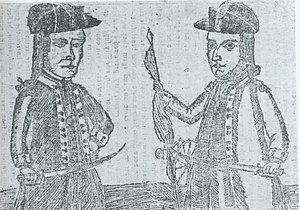Daniel Shay's Rebellion
| Shays' Rebellion | |||
|---|---|---|---|

Contemporary depiction of Daniel Shays (left) and Job Shattuck, two of the main protest leaders
|
|||
| Date | August 31, 1786 – June 1787 | ||
| Location | Western Massachusetts, U.S. | ||
| Caused by | Economic policy Aggressive tax and debt collection Political corruption and cronyism |
||
| Goals | Reform of state government, later its overthrow | ||
| Methods | Direct action to close courts; then military organization in attempt to capture the U.S. arsenal at the Springfield Armory | ||
| Result | Rebellion crushed, and problems of Federal authority linked to the Articles of Confederation spur U.S. Constitutional Convention | ||
| Parties to the civil conflict | |||
|
|||
| Lead figures | |||
|
|
|||
| Number | |||
|
|||
| Casualties | |||
|
|||
Shays' Rebellion was an armed uprising in Massachusetts (mostly in and around Springfield) during 1786 and 1787. Revolutionary War veteran Daniel Shays led four thousand rebels (called Shaysites) in an uprising against perceived economic and civil rights injustices. In 1787, the rebels marched on the United States' Armory at Springfield in an unsuccessful attempt to seize its weaponry and overthrow the government.
The rebellion took place in a political climate where reform of the country's governing document, the Articles of Confederation, was widely seen as necessary. The events of the rebellion affected debates at the U.S. Constitutional Convention, and ultimately the shape of the new government. Indeed, the shock of Shays' Rebellion drew retired General George Washington back into public life, leading to his two terms as the United States' first President. The exact nature and consequence of the rebellion's influence on the content of the Constitution and the ratification debates continues to be a subject of historical discussion and debate.
In the rural parts of New England, particularly in the hill-towns of central and western Massachusetts, the economy during the American Revolutionary War had been one of little more than subsistence agriculture. Some residents in these areas had little in the way of assets beyond their land and bartered with one another for goods or services. In lean times, farmers might obtain goods on credit from suppliers in local market towns who would be paid when times were better.
In the more economically developed coastal areas of Massachusetts Bay and in the fertile Connecticut River Valley, the economy was basically a market economy, driven by the activities of wholesale merchants dealing with Europe, the West Indies and elsewhere on the North American coast. Not surprisingly, the state government was dominated by this merchant class.
...
Wikipedia
